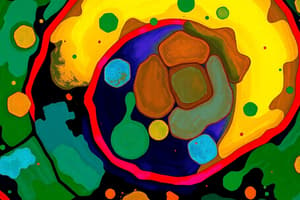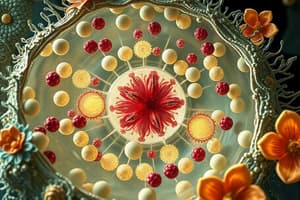Podcast
Questions and Answers
What is the primary function of ribosomes within animal cells?
What is the primary function of ribosomes within animal cells?
- Protein synthesis (correct)
- Waste management
- Photosynthesis
- Energy production
Which structure serves as a barrier and provides structure in animal cells?
Which structure serves as a barrier and provides structure in animal cells?
- Vacuole
- Nucleus
- Cell membrane (correct)
- Cytoplasm
What is the function of chloroplasts in plant cells?
What is the function of chloroplasts in plant cells?
- Storage of proteins
- Cell division
- Waste elimination
- Photosynthesis (correct)
Which organelle is responsible for energy production in both plant and animal cells?
Which organelle is responsible for energy production in both plant and animal cells?
What is the primary role of the Golgi body in a cell?
What is the primary role of the Golgi body in a cell?
Which of the following correctly describes organelles?
Which of the following correctly describes organelles?
What is the primary function of the nucleus in a eukaryotic cell?
What is the primary function of the nucleus in a eukaryotic cell?
Which process is not considered a function of a cell?
Which process is not considered a function of a cell?
What distinguishes eukaryotic cells from prokaryotic cells?
What distinguishes eukaryotic cells from prokaryotic cells?
What is heredity?
What is heredity?
What is the purpose of adjusting coefficients in a chemical equation?
What is the purpose of adjusting coefficients in a chemical equation?
In the equation H₂ + O₂ → 2H₂O, what are the total number of oxygen atoms in the products?
In the equation H₂ + O₂ → 2H₂O, what are the total number of oxygen atoms in the products?
What does a balanced chemical equation represent regarding mass?
What does a balanced chemical equation represent regarding mass?
Which is an essential step in the process of balancing chemical equations?
Which is an essential step in the process of balancing chemical equations?
Which of the following is NOT a characteristic of a balanced chemical equation?
Which of the following is NOT a characteristic of a balanced chemical equation?
What is the primary function of the chloroplast in plant cells?
What is the primary function of the chloroplast in plant cells?
During cellular respiration, what are the end products of glucose breakdown?
During cellular respiration, what are the end products of glucose breakdown?
Which component of a cell provides rigidity and structure, particularly in plant cells?
Which component of a cell provides rigidity and structure, particularly in plant cells?
What is the role of the vacuole in a cell?
What is the role of the vacuole in a cell?
What defines an ion in terms of its electrical charge?
What defines an ion in terms of its electrical charge?
Study Notes
Animal Cells
- Structure:
- Cell Membrane: Serves as a barrier and maintains cell structure.
- Microtubules: Provide cytoskeletal support.
- Cytoplasm: Acts as a fluid medium, supporting cell structures.
- Parts:
- Nucleolus: Located within the nucleus, responsible for ribosome production.
- Nucleus: The cell's control center, containing genetic material (DNA).
- Nuclear Membrane: Surrounds the nucleus, controlling the passage of molecules in and out.
- Functions:
- Ribosomes: Involved in protein synthesis.
- Rough ER: Synthesizes proteins.
- Smooth ER: Produces fats and carbohydrates.
- Golgi Body: Packages and stores proteins.
- Mitochondria: Responsible for cellular respiration (energy production) from carbohydrates.
- Vacuole: Stores water and waste, involved in diffusion.
- Lysosome: Degrades and recycles cellular components.
- Centriole: Plays a crucial role in cell division.
Plant Cells
- Structure:
- Cell Wall: Provides structural support and protection.
- Chloroplast: Responsible for photosynthesis, converting light energy into chemical energy.
- Vacuole: Typically larger in plant cells, primarily for water storage and maintaining turgor pressure.
- Internal Membrane: Contributes to the overall structure and function of the cell.
Cellular Functions
- Cytoplasm: A dense fluid that houses all the necessary components for essential cell functions.
- Cellular Respiration: A series of chemical reactions that break down glucose, releasing energy.
- Glucose: A simple sugar that serves as a primary energy source for cellular processes.
- Cell Wall: A rigid structure that encloses the cell membrane, providing support and protection in plant cells.
- Chloroplast: Essential for photosynthesis in plant cells, enabling them to convert light energy into chemical energy.
- Photosynthesis: The process by which plants utilize light energy to produce glucose from water and carbon dioxide.
- Vacuole: An organelle used for chemical storage within the cell.
- Ion: An atom or molecule that carries an electric charge.
Studying That Suits You
Use AI to generate personalized quizzes and flashcards to suit your learning preferences.
Description
Explore the intricate components of animal cells through this quiz. Learn about key structures such as the nucleus, ribosomes, and mitochondria, as well as their essential functions in cellular processes. Perfect for students studying cell biology or related subjects.





